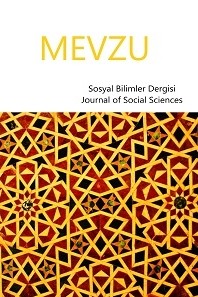Hindistan’ın Yapay Zekâ Gelişimi Üzerine Bir İnceleme
Yapay zekâ, Hindistan, Ekonomik rekabetçilik
An Analysis on India’s Artificial Intelligence Development
Artificial intelligence, India, economic competitiveness,
___
- AI School of India. (2021). How are AI-based solutions being used to combat COVID-19? INDIAai, https://indiaai.gov.in/article/how-are-ai-based-solutions-being-used-to-combat-covid-19.
- Acemoğlu, D. ve Restrepo, P. (2018). The Race between Man and Machine: Implications of Technology for Growth, Factor Shares, and Employment. American Economic Review, 108(6), 1488-1542.
- Acemoğlu, D. ve Restrepo, P. (2019). Automation and New Tasks: How Technology Displaces and Reinstates Labor. Journal of Economic Perspectives, 33(2), 3-30.
- Agarwal, P.K., Gurjar, J., Agarwal, A.K. ve Birla, R. (2015). Application of Artificial Intelligence for Development of Intelligent Transport System in Smart Cities. International Journal of Transportation Engineering and Traffic System, 1(1), 20-30.
- Agrawal, R., Wankhede, V.A., Kumar, A., Luthra, S., Majumdar, A. ve Kazancoglu, Y. (2021). An Exploratory State-of- the-Art Review of Artificial Intelligence Applications in Circular Economy using Structural Topic Modeling. Operations Management Research, 2021.
- Alonso, S.L.N., Forradellas, R.F.R., Morell, O.P. ve Jorge-Vazquez, J. (2021). Digitalization, Circular Economy and Environmental Sustainability: The Application of Artificial Intelligence in the Efficient Self-Management of Waste. Sustainability, 13(4), 1–20.
- Armstrong, S., Bostrom, N. ve Shulman, C. (2016). Racing to the Precipice: A Model of Artificial Intelligence Development, AI & SOCIETY, 31, 201-206.
- Chen, N., Christensen, L., Gallagher, K., Mate, R. ve Rafert, G. (2016). Global Economic Impacts Associated with Artificial Intelligence, Economic Impact Study. www.analysisgroup.com/uploadedfiles/content/insights/publishing/ ag_full_report_economic_impact_of_ai.pdf.
- Chidepatil A., Bindra P., Kulkarni D., Qazi M., Kshirsagar M. ve Sankaran, K. (2020). From Trash to Cash: How Blockchain and Multi-Sensor-Driven Artificial Intelligence Can Transform Circular Economy of Plastic Waste. Administrative Sciences, 10(2), 23.
- Dhanabalan, T. ve Sathish, A. (2018). Transforming Indian Industries Through Artificial Intelligence and Robotics in Industry 4.0. International Journal of Mechanical Engineering and Technology (IJMET), 9(10), 835–845.
- Cheng, J. ve Zeng, J. (2022). Shaping AI’s Future? China in Global AI Governance, Journal of Contemporary China, 2022.
- European Commission. (2016). Analysis of the Impact of Robotic Systems on Employment in the European Union—2012 Data Update. https://op.europa.eu/en/publication-detail/-/publication/fa9a1167-fcd6-4ed8- 9491-ce451fc22e9c
- Fisher, O.J., Watson, N.J., Escrig, J.E., Witt, R., Porcu, L., Bacon, D. ve Gomes, R.L. (2020). Considerations, Challenges and Opportunities When Developing Data-Driven Models for Process Manufacturing Systems. Computers and Chemical Engineering, 140, 106881.
- Furman, J. ve Seamans, R. (2018). AI and the Economy. NBER Working Paper No. w24689. https://ssrn.com/abstract=3194841
- Graetz, G. ve Michaels, G. (2018). Robots at Work. The Review of Economics and Statistics, 100(5), 753–768.
- IBM. (2022). IBM Global AI Adoption Index 2022. https://www.ibm.com/downloads/cas/GVAGA3JP.
- ITU. (2017). Measuring The Information Society Report 2017. https://www.itu.int/en/ITU- D/Statistics/Pages/publications/mis2017.aspx.
- Kaka, N., Madgavkar, A., Kshirsagar, A., Gupta, R., Manyika, J., Bahl, K. ve Gupta, S. (2019). Digital India: Technology to Transform a Connected Nation. www.mckinsey.com/~/media/McKinsey/Business%20Functions/McKinsey%20Digital/Our%20Insights/Digital%20 India%20Technology%20to%20transform%20a%20connected%20nation/MGI-Digital-India-Report-April- 2019.pdf.
- Kalyanakrishnan, S., and Panicker, R.A., Natarajan, S. ve Rao, S. (2018). Opportunities and Challenges for Artificial Intelligence in India. AAAI/ACM Conference on AI, Ethics, and Society, 164-170, New Orleans, LA, ABD.
- Nettel, P.F., Rogerson, A., Westgarth, T., Iida, K., Mbayo, H. Finotto, A., Rahim, S. ve Petheram, A. (2022). Government AI Readiness Index 2021. https://www.oxfordinsights.com/government-ai-readiness-index2021.
- Levy, F. (2018). Computers and Populism: Artificial Intelligence, Jobs, and Politics in the Near Term. Oxford Review of Economic Policy 34(3), 393-417.
- Marda, V. (2018). Artificial Intelligence Policy in India: A Framework for Engaging the Limits of Data-Driven Decision-Making. Philosophical Transactions of the Royal Society A, 376, 20180087.
- Menon, R. M., Vazirani, M. ve Roy, P. (2017). Rewire for Success: Boosting India’ AIQ. Accenture, https://www.accenture.com/content/dam/accenture/final/a-com-migration/r3-3/pdf/pdf-153/accenture-ai-for-economic-growth-india.pdf#zoom=50.
- Mokaya, V. (2019). Future of Precision Agriculture in India using Machine learning and Artificial Intelligence. International Journal of Computer Sciences and Engineering, 7(2), 1020-1023.
- Naudé, W. ve Dimitri, N. (2020). The Race for an Artificial General Intelligence: Implications for Public Policy, AI & SOCIETY, 35, 367-379.
- NITI Aayog. (2018). National Strategy For Artificial Intelligence #AIFORALL. niti.gov.in/writereaddata/files/document_publication/NationalStrategy-for-AI-Discussion-Paper.pdf.
- Petrarca, F. ve Terzi, S. (2018). The Global Competitiveness Index: An Alternative Measure with Endogenously Derived Weights. Quality & Quantity, 52, 2197-2219.
- Ghosh, S., Rao, A., Bhushan, R., Mitra, I., Datta, S., Das, R., Ashraf, Z., Sabir, M. H., Yadav, A. ve Palit, I. (2020). “AI: An Opportunity Amidst a Crisis.” PWC, https://www.pwc.in/assets/pdfs/data-and-analytics/ai-an-opportunity- amidst-a-crisis.pdf.
- Sarkar, D. (2017). Robotic Process Automation in Insurance Industry. https://www.nalashaa.com/robotic- process-automation-insurance-industry/.
- Schwab, K. (2019). The Global Competitiveness Report, World Economic Forum. www3.weforum.org/docs/WEF_TheGlobalCompetitivenessReport2019.pdf.
- Schwab, K. ve Zahidi, S. (2020). The Global Competitiveness Report: How Countries are Performing on the Road to Recovery, World Economic Forum. www3.weforum.org/docs/WEF_TheGlobalCompetitivenessReport2020.pdf.
- Sharma, M., Luthra, S., Joshi, S., Kumar, A. Implementing Challenges of Artificial intelligence: Evidence from Public Manufacturing Sector of an Emerging Economy, Government Information Quarterly, 2021, 101624.
- The World Bank. (2020). Individuals Using The Internet. https://data.worldbank.org/indicator/IT.NET.USER.ZS.
- Vlachokostas, C., Achillas, C., Agnantiaris, I., Michailidou, A.V., Pallas, C., Feleki, E. ve Moussiopoulos, N. (2020). Decision Support System to Implement Units of Alternative Biowaste Treatment for Producing Bioenergy and Boosting Local Bioeconomy. Energies, 13(9), 2306.
- Wagner, D.N. (2020). Economic Patterns in a World with Artificial Intelligence. Evolutionary and Institutional Economics Review, 17(1), 111-131.
- World Economic Forum. (2018). Country/Economy Profiles, Global Competitiveness Index 2017-2018. reports.weforum.org/global-competitiveness-index-2017-2018/countryeconomy-profiles/#economy=IND.
- World Economic Forum. (2020). Technology and Data Governance in Cities, Indian Cities at the Forefront of the Fight Against COVID-19. www3.weforum.org/docs/WEF_Technology_and_Data_Governance_in_Smart_Cities_India_2020.
- Yayın Aralığı: Yılda 2 Sayı
- Başlangıç: 2019
- Yayıncı: Ali SEVER
Yalan Haber Tespitinde Metodoloji Arayışları (İbn Kayyim ve İbn Haldûn Örneği)
lerlemeci Tarih Fikri Ekseninde Sosyolojide Dikotomiler ve Dualiteler
Sokrates, Platon ve Aristoteles’in Atina Demokrasisine Eleştirileri
Osmanlıda Haberleşme Sistemi Çerçevesinde “Diyarbakır Menzilleri”
Hindistan’ın Yapay Zekâ Gelişimi Üzerine Bir İnceleme
Hadis İlmi Açısından et-Teftâzânî’nin Şerhu'l-Akâid İsimli Eseri
Müzik Alanındaki Uzaktan Eğitim Çalışmalarına Yönelik Genel Bir Literatür Değerlendirmesi
